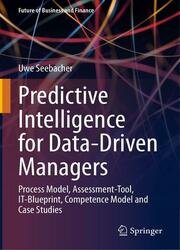 Название: Predictive Intelligence for Data-Driven Managers: Process Model, Assessment-Tool, IT-Blueprint, Competence Model and Case Studies
Название: Predictive Intelligence for Data-Driven Managers: Process Model, Assessment-Tool, IT-Blueprint, Competence Model and Case StudiesАвтор: Uwe Seebacher
Издательство: Springer
Год: 2021
Страниц: 275
Язык: английский
Формат: pdf (true)
Размер: 10.5 MB
This book describes how companies can easily and pragmatically set up and realize the path to a data-driven enterprise, especially in the marketing practice, without external support and additional investments. Using a predictive intelligence (PI) ecosystem, the book first introduces and explains the most important concepts and terminology. The PI maturity model then describes the phases in which you can build a PI ecosystem in your company. The book also demonstrates a PI self-test which helps managers identify the initial steps. In addition, a blueprint for a PI tech stack is defined for the first time, showing how IT can best support the topic. Finally, the PI competency model summarizes all elements into an action model for the company. The entire book is underpinned with practical examples, and case studies show how predictive intelligence, in the spirit of data-driven management, can be used profitably in the short, medium, and long terms.
Predictive Intelligence has developed from the term Business Intelligence to meet the need not only to evaluate data with foresight, but also to relate it directly to concrete management decisions—in the sense of valid decision and action recommendations. In recent years, the terms “Business Analytics” or “Analytics” have also come up, whereby these and similar terms are used interchangeably and confusingly. The increasing popularity of these and similar terms “Analytics” and “Business Analytics” can be attributed to the rapid developments in the field of data analysis with respect to, e.g., in-memory, advanced algorithms, Artificial Intelligence (AI) or Machine Learning, etc. which have massively increased the performance of Business Intelligence software. An ever more increasing number of new terms in the subject area of modern business management does not necessarily contribute to the necessary transparency and make it more difficult for top management to make the appropriate, necessary decisions for their own company and to initiate the right measures. Against this background, the following section describes and presents the current state of the PI ecosystem with the most important, established terms.
Artificial Intelligence (AI) originated in the field of computer science and is therefore also a subfield of computer science. AI is concerned with the automation of intelligent behavior and learning of machines, Machine Learning, as this will be defined later as part of the conceptual ecosystem of PI in 3 chapter.
A Hadoop cluster can simply be described as a coordinated hardware link to provide greater capacity for processing large, unstructured data sets. Hadoop clusters operate according to a master-slave model, a model for a communication protocol in which a device or process, called a master, controls one or more devices or processes, defined as slaves . The Hadoop cluster is thus a group of hardware that facilitates the use of open source Hadoop technology for data processing. It consists of a group of nodes. One node called the Name-Node is the Hadoop Master. This node communicates with various data node nodes in the cluster to support operations. Hadoop clusters also typically use other Apache open source technologies such as Apache MapReduce and Apache Yarn , which helps to route collaborative activities on virtual machines or containers through different nodes in the system. Hadoop clusters work in concert to handle large unstructured data sets and deliver data results.
Contents:
Скачать Predictive Intelligence for Data-Driven Managers: Process Model, Assessment-Tool, IT-Blueprint, Competence Model and Case Studies
